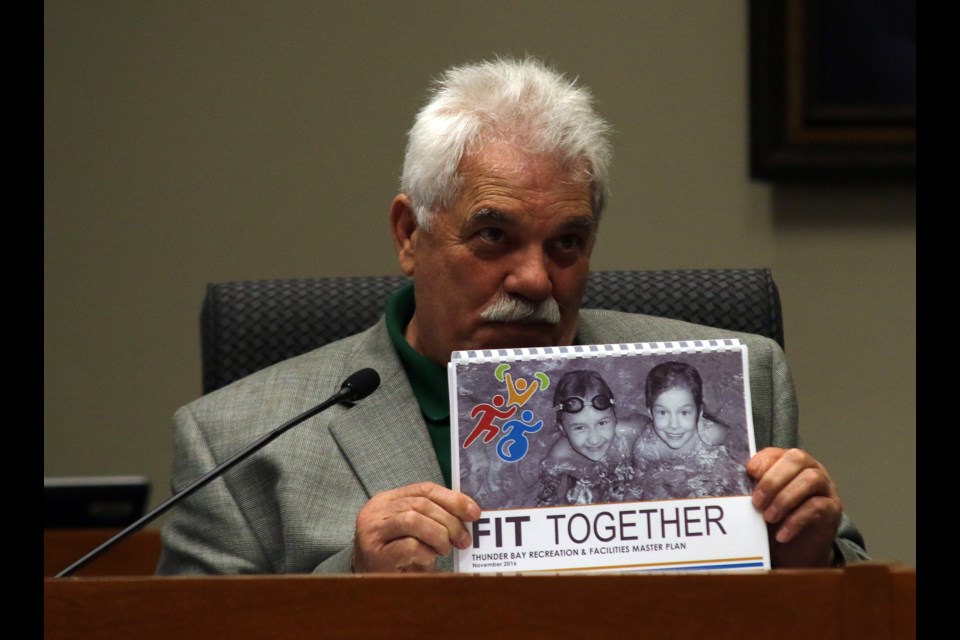THUNDER BAY -- City council met a recreation plan that's expected to last a generation on Monday as councilors pondered how it would roll out over the city's changing demographic landscape.
The proposed Recreation Master Plan known as Fit Together includes ambitions to double some ice rinks while re-purposing others,install outdoor splash pads, support seniors centres on both sides of the city and build gymnasiums at the Canada Games Complex and Churchill Pool sites.
It also urges administration to work alongside newly-created boards in all 12 neighbourhood community centres that will deliver tailored programming at the neighbourhood level.
Sierra Planning and Management director Jonathan Hack urged councilors to see the plan as a guiding hand rather than a project list set in stone.
"It's a long-term plan. It's a vision," Hack said after council held a lengthy debate to receive the plan, which will return for approval on Jan. 16, 2017,
"Each of the major capital projects are projects unto themselves with a planning process and a funding requirement that's going to result, I think, in a lot of discussion back at city council. By approving the plan, you're not signing onto some of these changes, which are fairly significant."
The significance will amplify when it dovetails with the Chapples Park Master Plan, the latter of which includes options ranging from making the park a neighbourhood hub to making it a recreation destination. The recreation plan also assumes Thunder Bay will eventually build an Events Centre as an element of its arena programming.
The plan was built on 1,400 online surveys as well as analysis of the city's demographic data but the conversation around the council table turned to population changes and it strained at times.
The enormous scope and unspecified cost of the plan meant nearly all councilors had some concern over a specific project or direction, mostly related to neighbourhoods.
"“The optics of closing a pool and selling it for residential, I can’t support that," said Current River Ward Coun. Andrew Foulds, commenting on the report's recommendation to close Dease Pool, which is outside of his ward.
"However I need, and I think the public needs, to have a sense of how the process will unfold to meet the needs of that community because quite clearly, Dease Pool serves that neighbourhood. I need some confidnece that the needs of that neighbourhood will continue to be met."
Foulds asked to be briefed on the infrastructure in his ward before the report returns in January.
Red River Ward Coun. Brian McKinnon sees a "major transition" underway in Grandview, where he claims 50 young families have taken up residency and small parks that have been empty are now full.
"It’s not just Grandview. If you look around the city, there’s great transitions going on so they have to then move stuff into those neighbourhoods," he said.
"I think the overall plan is terrific. They have some really good, sound ideas. I just think if they’re going to be putting stuff somewhere, know where the people are who are going to use it.
The plan connects city-wide facility networks as well as promising neighbourhood development. Westfort Ward Coun. Joe Virdiramo isn't concerned councilors would compete for recreation infrastructure.
"I’ve been on council 13 years and that has never happened," he said.
"We will state our view, try to do the best we can – not only for the ward but for the city. For instance, I’d prefer that the new recreation facility be on the south side, which is Westfort, not in Northwood, closer to the Canada Games Complex. That isn’t much of a distance there."
"...except there isn't that much land in Westfort where we could do it," chimed in Coun. Iain Angus. "We'd have to purchase a lot of homes and you'd lose a lot of your citizens."
Coun. Larry Hebert raised questions as to whether the current demographics are accurate. He suggested as many as 15,000 Indigenous people who live elsewhere in Northwestern Ontario are in Thunder Bay at any given time and that Lakehead University and Confederation College contribute a net 7,600 people to the city, most of which are using recreational facilities.
"They’re not counting our population stats. When they say kids are going down, maybe non-Indigenous population’s going down but the Indigenous population is growing and we have to take care of them from a recreation standpoint," Hebert said.
"What about Fort William First Nation? It’s not even included in the report. They were our partners, supposedly."
